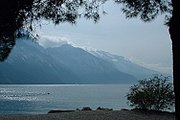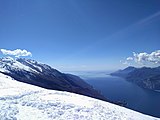Monte Baldo
| Monte Baldo | ||
|---|---|---|
|
Monte Altissimo di Nago, the northernmost tip of Monte Baldo |
||
| height | 2218 m slm | |
| location | Provinces of Trento and Verona , Italy | |
| Mountains | Garda mountains | |
| Notch height | 1950 m | |
| Coordinates | 45 ° 43 '34 " N , 10 ° 50' 38" E | |
|
|
||
| rock | limestone | |
| particularities | Endemic | |
The Monte Baldo is a 30-kilometer-long mountain ridge between Lake Garda and the Adige , which is part of the mountain range of the Lake Garda Mountains .
geography
Monte Baldo is bordered in the north by the Loppio valley, in the east by the Adige Valley , in the west by Lake Garda and in the south by the moraine hills near Rivoli Veronese and the plain near Caprino Veronese .
It does not have an excellent peak, but it does have a few peaks: Monte Altissimo di Nago (2,078 m), Cima del Longino (2,180 m), Cima delle Pozzette (2,132 m), Cima Valdritta (2,218 m) and Punta Telegrafo (2,200 m). The deepest cut in the ridge of Monte Baldo is the Bocca di Navene saddle at 1,425 m. Apart from the Lago di Loppio at the north end and the reservoir Lago di Prà della Stua, there are no larger standing waters on Monte Baldo .
The geological origin of Monte Baldo can be traced back to the deposits of various limestones in the Mesozoic Era in the warm Tethys Sea , which were folded up when the Alps were formed. In addition to sediments , traces of igneous rocks such as basalt and tuff can also be found on the Baldo . The current shape goes back to four ice ages that formed the ridge. There are still some traces of the last Würm Ice Age , such as large sanded rock slabs, glacier pots and moraine hills.
Flora and fauna
For botanists , Monte Baldo is a veritable treasure trove of species, which is why it was known as the Hortus Italiae (English: the garden of Italy) as early as the 16th century .
Because the western flank of Monte Baldo rises from Lake Garda to 65 m to over 2,200 m, there are several levels of vegetation over a relatively short distance , ranging from sub-Mediterranean flora with olive groves and holm oak forests to alpine species in the summit regions. Some plant species are found only here, so are endemic , such as the cores Generic jewelry flower that Gypsophila baldensis a type of gypsophila and Brassica baldensis a kind of cabbage . This is because Monte Baldo was a nunatak , a mountain whose peaks protruded from the ice sheet during the ice ages. The ice-free peaks formed an island in the Tertiary of North immigrant flora and fauna, but also for Mediterranean plants in the warm interglacial periods had become home here.
The study of the flora of Monte Baldo, especially medicinal plants , goes back to the 16th century. In 1566, the Verona- born pharmacist and botanist Francesco Calzolari published the first list of plants that he had found on the Baldo, the collection of which is now in the Natural History Museum in Verona. In 1617 the first book, illustrated with wood engravings , was published by Giovanni Pona , who is considered to be the first botanist of Monte Baldo. Since then, the flora of Monte Baldo has been in the interest of research.
Many plants were found and described for the first time on Monte Baldo and were therefore given the scientific nickname "baldensis" like the Monte Baldo sedge or the Monte Baldo anemone , even if they can be found elsewhere.
In a similar way, this also applies to certain insects, such as the Monte Baldo mountain hermit or the Cychrus cilindrocollis from the genus of the shovel runner .
There are several protection zones on Monte Baldo, such as the Parco naturale locale del Monte Baldo in the north of the massif, created in 2013, and the Riserva Naturale Integrale Gardesana Orientale and Riserva Naturale Integrale Lastoni Selva Pezzi both near Malcesine.
Tour possibilities
The Funivia Malcesine-Monte Baldo cable car leads from Malcesine in two sections to the Tratto Spino mountain station at 1760 m above sea level . It serves the connected ski area in winter and is used by hikers and cyclists in summer, who use various gravel slopes here as downhill routes. Monte Baldo is also extremely popular as a starting point for paragliders due to its easy accessibility via the cable car and the enormous difference in altitude (1680 m) to the landing site in Malcesine. Safety training over water is held here regularly.
The Telegrafo mountain huts in the south and Altissimo in the north can be reached from the mountain station, both of which are connected to the Tratto Spino via the Monte Baldo Höhenweg ( Alta via del Monte Baldo in Italian ) .
Impressions
- Impressions - with a view from and to Monte Baldo
View from Tignale
From Riva del Garda across Lake Garda
View of Lake Garda in spring
literature
- Luciano Costantini, Lil De Kock: Flora del Monte Baldo = picture flora of Monte Baldo . Comitato gruppi alpinistici veronesi, Verona 2009.
- Johannes von Frischauf : A trip to Monte Baldo . Vienna 1883
Web links
Individual evidence
- ↑ Luciano Costantini, Lil De Kock: Flora del Monte Baldo = picture flora of Monte Baldo pp. 23–24
- ^ Research history of Monte Baldo (Italian) accessed on January 22, 2018
- ↑ a b Luciano Costantini, Lil De Kock: Flora del Monte Baldo = picture flora of Monte Baldo p. 24
- ↑ Luciano Costantini, Lil De Kock: Flora del Monte Baldo = picture flora of Monte Baldo p. 15
- ↑ Francesco Calzolari (1521-1600) (Italian) accessed on January 22, 2018
- ^ Giovanni Pona (1565-1630) (Italian) accessed January 22, 2018
- ^ Entomologi italiani (Italian), accessed January 22, 2018
- ↑ Parco Naturale Locale Monte Baldo (English) accessed on January 21, 2018.
- ^ Riserva Gardesana orientale (Italian) accessed on January 21, 2018.
- ↑ Riserva Lastoni Selva Pezzi (Italian) accessed on January 21, 2018.










